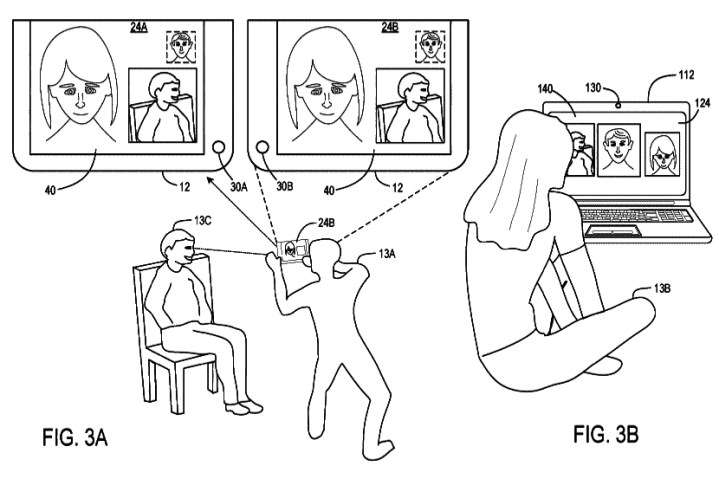
Although Microsoft’s two-screen pocket-sized Andromeda device appears to be dead in the water for now, the company apparently still has multi-screen devices on its radar. A patent application published earlier this month describes a hinged multi-screen device that supports three-way video calling. Each screen will sport a camera, enabling two people to chat on the device with a third person on the other end of the call.
According to the patent, each screen will render the video feed from their embedded cameras, the video feed from the opposite screen’s camera, or from the video feed sent by the remote caller. Based on that description, the software would simply present the video of the current person speaking: you, the other person on the same device, or the individual on the remote device. But as shown above, all three individuals could be shown together on each screen.
Microsoft’s patent addresses a current problem when multiple users are participating in a call. When you and your friends are attempting a group chat on Friday night using a single-screen device, something is going to break with multiple heads trying to cram into one camera’s view. With two screens and two cameras involved, there is a smaller chance of congestion and bruises.

The patent reveals the device to include a processor, storage, system memory, sensors, an orientation module (accelerometer), “two or more display devices,” and front-facing cameras. In one diagram, Microsoft shows a standing individual holding and talking to the device while a second person sits in a chair, chatting through the held device’s second screen.
Outside holding the device, the patent describes an angular orientation up to 90 degrees, meaning you would simply place it on a surface vertically in an L-shaped manner. The open angular orientation would be between 90 and 270 degrees whereas a back-to-back orientation would be 270 to 360 degrees.
“The computer program executed by the processor includes an orientation module,” the patent describes. “As shown, the orientation module is configured to receive sensor data from the sensor devices. Based on the sensor data, the orientation module is configured to detect a current angular orientation between the pair of display devices indicating that the pair of display devices are facing away from each other.”
If you followed the Andromeda rumors, this device should sound all-too-familiar. Given the recent shift inside Microsoft, the company supposedly put its two-screen device on hold because it really had no supporting ecosystem or target audience. Insiders said it had telephony features, too, although it wasn’t designed to replace smartphones.
Presumably, this patent is related to Andromeda, originally submitted to the U.S. Patent & Trademark Office in June 2017 when Microsoft was supposedly still in full swing with designing Andromeda. The patent went live on July 3, and even if Andromeda may never surface, Microsoft will still hold rights to the design if approved.
Still, what the patent doesn’t mention is size. With that said, this design could cover a pocket-size device or something larger like a two-screen laptop.


